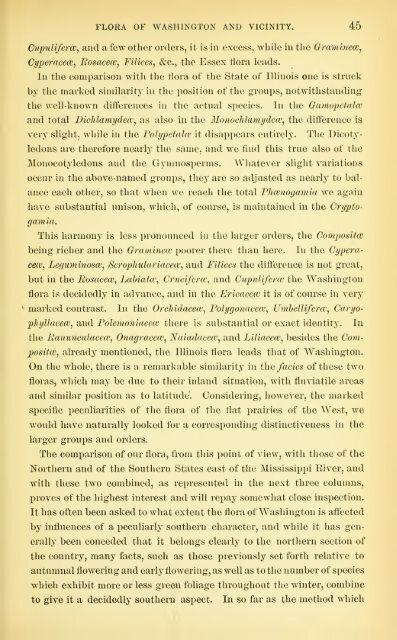Bulletin - United States National Museum - Smithsonian Institution
Bulletin - United States National Museum - Smithsonian Institution
Bulletin - United States National Museum - Smithsonian Institution
You also want an ePaper? Increase the reach of your titles
YUMPU automatically turns print PDFs into web optimized ePapers that Google loves.
FLORA OF WASHINGTON AND VICINITY. 45<br />
Ci(puUferce, and a few other orders, it is in excess, while in the Graminece,<br />
Cyperacece, Bosacecc, Filices, &c., the Essex flora leads.<br />
In the comparison with the flora of the State of Illinois one is struck<br />
by the marked similarity in the position of the groups, notwithstanding<br />
the well-known differences in the actual species. In the Gamopetalce<br />
and total Dichlamydece, as also in the MonochJamydea'^ the difference is<br />
very slight, while in the PoJypetalw it disappears entirely. The Dicoty-<br />
ledons are therefore nearly the same, and we find this true also of the<br />
Monocotyledons and the Gymnosperms. Whatever slight variations<br />
occur in the above-named groups, they are so adjusted as nearly to bal-<br />
ance each other, so that when we reach the total Phccnogamia we again<br />
have substantial unison, which, of course, is maintained in the Crypto-<br />
gamia.<br />
This harmony is less pronounced in the larger orders, the Composites<br />
being richer and the Graminece poorer there than here. In the Cypera-<br />
cece, Leguminosw, Scrophulariacew, and Filices the difference is not great,<br />
but in the Rosacece, Labiatw, Cruciferw, and Cupuliferce the Washington<br />
flora is decidedly in advance, and in the Ericacece it is of course in very<br />
marked contrast. In the OrchidaceWj Polygonacew, UmhelUferw, Caryo-<br />
phyllacew, and Polemoniacccv there is substantial or exact identity. In<br />
the Banunculacece, Onagracecv, Naiadacece, and Llliacew, besides the Com-<br />
positcB, already mentioned, the Illinois flora leads that of Washington.<br />
On the whole, there is a remarkable similarity in the fades of these two<br />
floras, which may be due to their inland situation, with fluviatile areas<br />
and similar position as to latitude. Considering, however, the marked<br />
specific peculiarities of the flora of the flat prairies of the West, we<br />
would have naturally looked for a corresponding distinctiveness in the<br />
larger groups and orders.<br />
The comparison of our flora, from this point of view, with those of the<br />
Northern and of the Southern <strong>States</strong> east of the Mississippi Eiver, and<br />
with these two combined, as represented in the next three columns,<br />
proves of the highest interest and will repay somewhat close inspection.<br />
It has often been asked to what extent the flora of Washington is affected<br />
by influences of a peculiarly southern character, and while it has gen-<br />
erally been conceded that it belongs clearly to the northern section of<br />
the country, many facts, such as those previously set forth relative to<br />
autumnal flowering and early flowering, as well as to the number of species<br />
which exhibit more or less green foliage throughout the winter, combine<br />
to give it a decidedly southern aspect. In so far as the method which

















